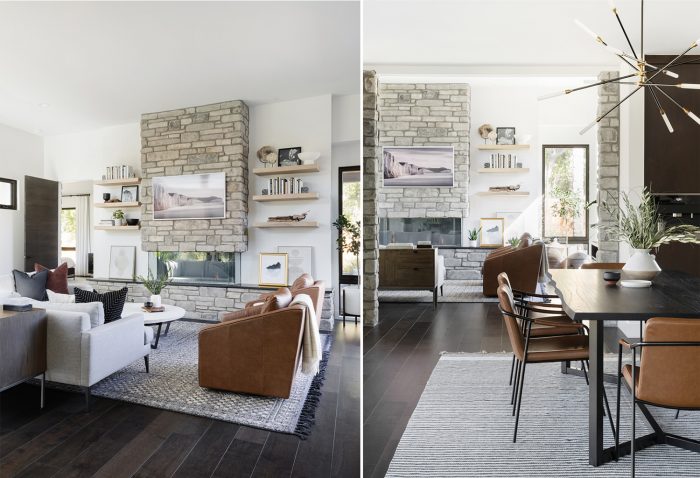Whether you have a cool industrial loft space, a studio apartment, or a modern home with a quasi-open floor plan, these free-flowing layouts all pose the same design dilemma when it comes to selecting rugs. How does one mix and match different rug styles without creating visual chaos?!
While open floor plans maximize square footage and offer the light, bright, and airy aesthetic that’s dominated the last decade, they make it virtually impossible to give each room its own signature style. Instead, all rooms exist in the same visual plane and therefore should complement one another, starting with the rugs.
Ahead, Havenly designers answer the age-old question: how do you coordinate rugs in an open floor plan? Find our 11 pro tips below, alongside real-life client projects that nailed it.
1. Vary scale

Image credit: Interior Define
To create subtle contrast, vary the scale of the print from rug to rug. In the above open-concept brownstone, for example, the two rugs share a color palette, but switch it up when it comes to repeat and scale. The rug on the left features a tighter, smaller repeat, while the one on the right leans large and slightly abstract. This visual variation keeps things interesting and cohesive at the same time.
2. Go tonal

For a foolproof rug aesthetic, work within a consistent color scheme, but choose mixed patterns for a sense of complementary separation. In the above living room, for example, the black and ivory tones carry through from the entryway to the living room, while the patterns are distinct. The first is a grounded, centered design, while the second contains repeating motifs in a smaller scale.
3. Coordinate colors

Always work within a coordinated palette to tie disparate rug styles together. But you don’t have to go with a monochrome color scheme — choose shades that play well with each other and complement the surrounding tones in the furniture and decor. Take this playful, boho vintage ensemble: the front Reading Room rug boasts a mix of berries, blues, and blacks in a global-inspired aesthetic, while the second is a navy Persian number.
4. Contrast texture

You can also create balance and contrast via texture in addition to color palette. In the above home, for example, the dining room boasts a subtly patterned wool rug with tassels, while the living room features a neutral, textured jute rug. The look is very Scandi minimalism, and so cozy.
5. Mix old and new

When in doubt, juxtapose a modern abstract rug with a vintage beauty, like in the above home. The area rug is a neutral modern print, while the kitchen runner adds a high-contrast edge with a black palette and vintage charm. Not only do the colors harmonize with each other, but the mix of geometric patterns with old-world designs keeps things feeling fresh and interesting.
6. Play with patterns

Again, working within a consistent palette (notice a theme here?), juxtapose patterns for a sense of contrast. In the above open floor plan, an area rug with a linear print is set against a more intricate, yet still geometric, global-inspired motif. The rugs are just different enough to play well off each other.
7. Bring in hides

Hides can be a wonderful addition to an open floor plan — they add natural contrast in both texture and shape. Here, both rugs boast a neutral hue to complement the otherwise high-contrast palette of the space, but the living room area rug features a modern graphic repeat that pairs beautifully with the ash gray hide in the adjoining dining area.
8. Invert the colors

Looking for an easy but incredibly effective way to coordinate rugs with a hint of drama? Simply invert the color schemes in the adjoining rooms. The above living room boasts clean white walls and an ivory rug with a charcoal border, while the dining room features the opposite: charcoal walls and a charcoal rug with a white border. The look is simple and coordinated, but interesting.
9. Embrace subtle classics

You can still create an interesting, layered design when sticking to the classics. A subtle diamond checkerboard rug adorns the living room, while a solid gray and white stripe sits nearby in the dining space. Together, they offer subtle visual variation and neutral texture in spades.
10. Play with neutrals

If your home features more color in the surrounding furniture and decor (whether in the form of animal print or fun florals), you can stick to the basics when it comes to rugs. Here, both textiles are neutral, minimalist, and simple, but provide the perfect neutral canvas for the warmer color palette.
11. Go distressed

When in doubt, pair a graphic, modern print (like the above hexagonal pattern) with its polar opposite: distressed and abstract. The stark contrast in patterns feels interesting, while the neutral color scheme unifies the two rooms.
From mixing rug styles to perfecting room flow, our designers are chock-full of expert tips. Check out our design packages to work with a design pro one-on-one.

